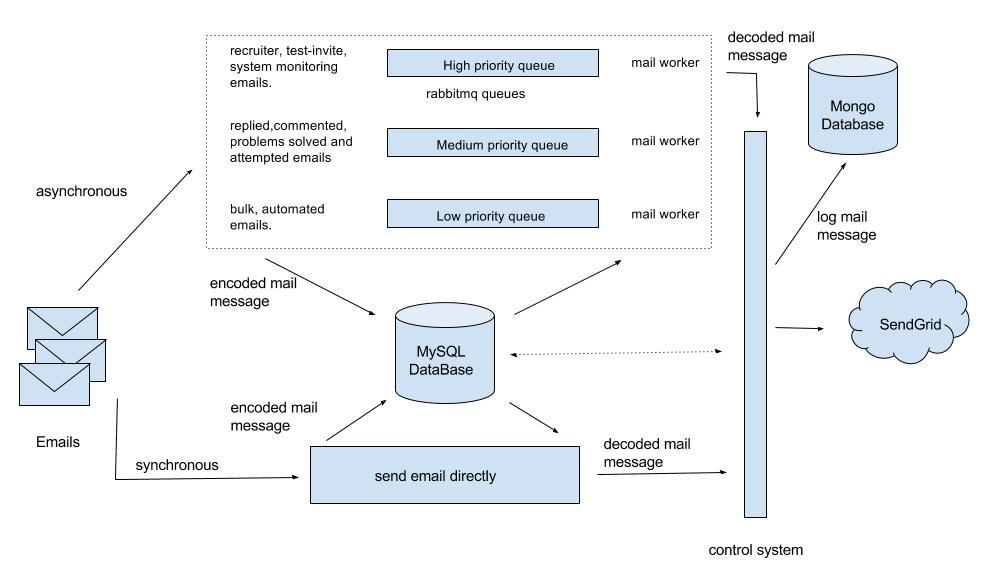Sending emails to our half million and growing user community
At hackerearth we send emails to keep our users updated on upcoming challenges and their activities, for example, when a user successfully solves a problem, receives test-invitation, updates on user comments. Basically whenever it is appropriate.
Architecture
It takes lot of computational power to send emails in such large quantities synchronously. So we have implemented an asynchronous architecture to send emails.
Here is brief overview of the architecture:
Step 1: Construct an email and save the serialized email object in database.
Step 2: Queue the metadata for later consumption.
Step 3: Consume the metadata, recreate the email object and deliver.
The diagram below shows high level architecture of emailing system. The solid line represents the data flow between different components. The dotted line represents the communications. Hackerearth email infrastructure consists of MySQL database, MongoDB database, RabbitMQ queues.

Journey Of Email
Step 1 - Construct email:
There are two different type of emails.
- Text - Plain text emails
- Html - Emails with rich interface using html elements. These emails are made using django templates
API used by hackerearth developers for sending email -
send_email(ctx, template, subject, from_email, html=False, async=True,
**kwargs)
The above API creates Sendgrid Mail object, serializes and saves it in the db with some additional data.
A piece of code similar to the bit shown below is used to create sendgrid Mail object
import sendgrid
sg = sendgrid.SendGridClient('YOUR_SENDGRID_API_KEY')
message = sendgrid.Mail()
message.add_to('John Doe <john@email.com>')
message.set_subject('Example')
message.set_html('Body')
message.set_text('Body')
message.set_from('Doe John <doe@email.com>')
status, msg = sg.send(message)
Model below is used for storing the serialized mail object and additional data.
class Message():
# The actual data - a pickled sendgrid.Mail object
message_data = models.TextField()
when_added = models.DateTimeField(default=datetime.now, db_index=True)
After constructing and saving the email object in the database, metadata is queued in the rabbitmq queues. Following section explains this in detail.
Note: send_email() API can send synchronous emails. Switch the flag ‘async’ to False to send synchronous emails. This will bypass all the asynchronous architecture and directly delivers the emails to inbox. But this is used to send extremely important emails, for example, infrastructure monitoring, alarms, and for monitoring email infrastructure itself.
Step 2 - Queue the metadata:
Not all emails have same importance in terms of delivery time. So, we have created multiple queues to reduce waiting time in queue for important mails.
- High priority queue
- Medium priority queue
- Low priority queue
It’s up to the application developer to decide the importance of the email and queue it in appropriate queue.
We queue the following metadata in the queue as a json object:
{‘message_id’: 123}
Step 3 - Reconstruct and deliver:
We run delivery workers, which consume metadata from queues, reconstruct email object and deliver it.
These workers consumes the messages from rabbitmq queues and fetches the message object from Message model(explained in the section above), deserializes the data to reconstruct the sendgrid Mail object.
We run different number of workers depending on the volume of emails in each queue.
Before sending email we do final checks which help us to make decision whether to deliver the email or not. For example, if the email id is blacklisted, if the emails have non-zero number of receivers.
After request is sent to sendgrid for delivering the email, these email objects are logged into a MongoDB to maintain the history of delivered emails.
###A/B Test In Emails###
Million emails requires optimization to improve user experience. This is done through A/B tests on emails type. We can test emails for subject and content variations. Every user on hackearth is assigned a bucket number to ensure emails are consistent during the experiment . Every A/B experiment is defined as dictionary mapped constants with all the information.
Here is one example of an A/B test with subject variation.
"""
EMAIL_VERSION_A_B
format of writing A/B test
key: test_email_type_version_number
value: email_dict
format for email_dict
keys: tuple(user_buckets)
values: category, subject, template
"""
EMAIL_VERSION_A_B = {
'A_B_TEST_1': {
tuple(user_bucket_numbers):{'a_b_category': 'email_category_v1',
'subject': 'Hello hackerearth',
'template': 'emails/email.html'
},
tuple(user_bucket_numbers):{'a_b_category': 'email_category_v2',
'subject': 'Welcome hackerearth',
'template': 'emails/email.html'
}
}}
New Experiments must update EMAIL_VERSION_A_B with experiment data.
Information from EMAIL_VERSION_A_B is used to update the
key word arguments of hackerearth sending email API(send_email).
The category is propagated to update the category of sendgrid Mail object.
Categories are used to see the variations in open rate and click rate for different A/B
experiments.
Feel free to comment below or ping us at support@hackerearth.com if you have any suggestions!
Posted by Kaushik Kumar.
Thanks to Pradeepkumar Gayam for improving it

